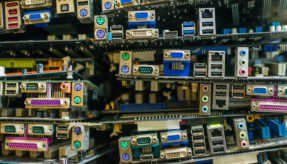
Managing aging equipment is a serious issue in manufacturing for military applications, characterised by long lead times, complex requirements for regulatory compliance, and equipment that is expected to last for decades. Here Jonathan Wilkins, director at automation parts supplier EU Automation, illustrates the challenges of obsolescence in the defence sector and shares his expert advice on how to face them.
According to the definition from the International Institute of Obsolescence Management (IIOM), obsolescence is the unavailability of parts or services that were previously available. Obsolescence occurs when the components of a system are no longer produced by the original equipment manufacturer (OEM), or when the latter is no longer in business. This means that when original components break or experience a malfunction, replacements can be hard or even impossible to find.
In the defence sector, the correct management of ageing equipment is particularly tricky. Defence systems such as military aircraft, navy solutions and missile defence systems are expected to last for several decades, but their components often have an operational life of no more than five years. This incongruence brings many disadvantages, such as the necessity to stock on spare parts to keep the system operational for as long as possible.
To complicate things, defence is a highly regulated field, and using components that have not been previously approved can be problematic. If a component breaks and an exact replacement is not available, installing a different part means that that entire system might have to be re-tested and re-certified.
The cost of obsolescence
Obsolescence is a costly business. Though its exact cost varies on a case-by-case and country-by-country basis, evidence shows that its impact on the defence sector is very costly and that solutions to mitigate its negative consequences are urgently needed. For example, the US Navy estimates that obsolescence-related issues cost them up to 750 million dollars annually, a huge amount that inevitably impacts American taxpayers.
Most worryingly, obsolescence can occur at any time during a component’s life cycle, meaning that components can become obsolete before defence systems are even up and running. Electronic components are among the most critical ones, since their life expectancy is relatively short when compared to other components.
According to Prof. Peter Sandborn, director of the mechanical engineering department of the University of Maryland, it is not unusual that 70 to 80 per cent of electronic components in a military system become obsolete before that system enters service. This is due to the long lead time that characterise the defence sector, where every phase of a component’s design, production and installation is strictly regulated.
In the long run, these expenses add up and impact the final cost of a defence system. For example, according to Profs. John Erkoyuncu and Roy Rajkumar from Cranfield University, the total through-life obsolescence cost for the Nimrod MRA4, a maritime reconnaissance aircraft, was around 780 million pounds. This aircraft was never even operated, and yet it cost a fortune in terms of obsolescence management.
National authorities are on the lookout for innovative solutions to reduce obsolescence-related costs. However, it’s not just a question of budgeting: from a military perspective, the true cost of obsolescence is under-performing equipment and ultimately reduced safety.
The problem with COTS
Commercial off-the-shelf (COTS) products offer designers of military systems access to cost-effective alternatives to bespoke solutions. However, as the name suggests, these parts have not been specifically designed for the military market and might not perform adequately in this context.
To meet a wider range of performance requirements, COTS manufacturers may not have specified these components for operation over wider temperature ranges, or with greater tolerance to high voltage, or with a proven resistance to harsh environments.
The result is that COTS tend to deteriorate easily in military applications. Nowadays, most current commercial and industrial designs are in production for five years or less and the life span of those designs continues to shrink. As a consequence, while the lifecycle of a military system is usually twenty years or more, many of its components will last for no more than five years.
Despite that, the use of COTS in defence systems has been widely promoted by national authorities to reduce production time and costs. Finding sustainable solutions to COTS obsolescence is therefore paramount.
Additive manufacturing: a viable alternative?
Recent advancements in additive manufacturing (AM) represent a promising alternative to managing some aspects of obsolescence. Several national authorities, including the US and the Swiss Governments, have already established research programmes that explore the possibilities of this innovative production technique.
AM involves producing components using 3D-printing techniques. The components’ material is initially in the form of metal powder, which is melted with a laser layer after layer. Using this method, there is the potential to 3D-print any part, in any shape, using an a wide range of materials.
Materials that are extremely resistant, and therefore perfect for military applications but very hard to handle, can now be printed into the desired shape. For example, Swedish engineering company Sandvik has recently 3D printed an exceptionally durable diamond composite that is ideal for military applications.
Although many predict that AM could potentially solve the problem of sourcing obsolete replacement parts, there are still serious technical and bureaucratical questions that this technology cannot answer.
Newly fabricated parts are hard to implement in defence, and sorting out regulations will take years. For example, it is unclear to which regulations these components should comply to make sure that they are safe to use in the military sector. Another potential problem is that at the moment there are no laws in place to determine the intellectual property rights of additively manufactured components.
From a strictly technical point of view, the main shortcoming of AM is that while this technology could help manage obsolescence for mechanical components, it is not clear if it would help with other types of obsolescence, for example for electronics.
Solutions that only tackle one aspect of obsolescence can only partially help. Electronic components, mechanical components, materials, software, skills, can all be subject to obsolescence. For this reason, solutions that deal with all aspects of obsolescence are always preferable.
A holistic approach to obsolescence management
The life cycle of a defence system is divided into six phases: concept, assessment, demonstration, manufacture, in-service and disposal—the so-called CADMID cycle. Obsolescence can occur during any of those phases for any component of the system. Therefore, a holistic approach to obsolescence management has to be implemented already in the early stages of any military project.
There are two approaches to holistic obsolescence management: reactive and proactive. The reactive approach consists in taking measures to substitute or repair parts once a breakdown happens, while the proactive approach is based on constant monitoring and planning to prevent breakdowns from occurring in the first place.
A proactive approach is of course preferable in that it allows manufacturers for the military sector to plan in advance, sourcing spare parts where it is most convenient and minimising downtime due to unexpected breakage.
There are three main areas in which a proactive approach to obsolescence management can be beneficial: design, supply chain and maintenance planning. In the design phase, it’s best to privilege open system architectures and modularity, so that parts can be substituted more easily.
In the supply chain, it’s important to have partnering agreements with a trustworthy supplier that can deliver parts quickly and efficiently, minimising downtime. Finally, it’s important to have an obsolescence management plan in place. To help with that, hiring an obsolescence manager can be a good solution. These professionals can help track the life phases of military equipment, monitor the condition of machinery and tools, and plan necessary maintenance before breakage even happens.
If you would like to join our community and read more articles like this then please click here.
defence equipment EU Automation Jonathan Wilkins obsolescence







